
Although the two terms are sometimes used interchangeably, "USB" and "pen drive" refer to different computer technologies. USB refers to the data transfer and peripheral connection system used to move data from a computer hard drive to different appliances, whereas a pen drive is a portable memory stick used to store information from a computer. In other words, the pen drive is the memory stick itself, while USB describes the system by which data is ported from the computer to the pen drive.
USB
Video of the Day
Universal Serial Bus, or USB, is a technological protocol developed in the 1990s to standardize connections between computers and the growing number of computer peripheral devices, including cameras, external hard drives, memory sticks and audio-visual recorders. The USB protocol governs everything from the USB ports on the sides of most computers to the USB cables that connect the computer to USB-compliant devices like iPods, joysticks or keyboards. USB refers to the technology used in these connections, a series of flat pins found in the connection headers that both transfer data and transmit electrical current to charge peripheral devices.
Video of the Day
Pen Drive

Also known as "memory sticks," "USB sticks" or "flash drives," pen drives are small data storage devices used to move and store information from a computer. The devices are essentially small hard drives, although they have no moving parts or processing power and are used exclusively for storage. A pen drive is inserted into a port on a personal computer and the computer's operating system moves files onto or off of the drive for storage. Pen drives are most often used to move documents or files from one computer to another, much as you would use a CD or floppy disk, but pen drives tend to be smaller, more portable and have more capacity than most removable disks.
Definition of a Pen Drive
As the most common system used to connect computers to external peripherals, USB interfaces are included in most modern pen drives, meaning that the drives can be inserted into the USB ports on the side of the computer and USB technology is used for data transfer. Most pen drives use USB technology, which explains the common use of terms like "USB stick" or simply "USB." To be more exact, however, a pen drive is a data storage device, while USB is a data transfer technology. A pen drive would continue to be a pen drive if it used wireless, bluetooth or a phone line to move data from the computer to its memory chips. The USB interface on a pen drive creates an avenue to move data while the pen drive itself stores it. In that sense, the USB plug is a part of a pen drive, but the definition of a pen drive is its function -- data storage on its internal memory chips.
Trends and Developments
Both USB and pen drive technology are evolving rapidly to anticipate the ever-growing data transfer needs of new computers, applications and peripheral devices. Pen drives, for example, have not only increased their storage capacity but the endurance of the devices to write and erase cycles, meaning that data can be moved on and off the drive more times while still guaranteeing the integrity of the drive and the information. In order to keep up with these developments, USB has also refined technologies to increase the data-transfer rate to and from peripherals, while venturing into new high-speed and wireless technologies. With the two technologies evolving in parallel, USB is likely to be the preferred data transfer protocol for pen drives for some time, yet understanding that the two terms describe different technologies helps clarify this relationship and better understand the directions both are likely to take in the future.